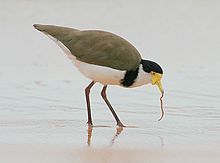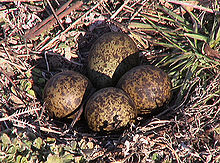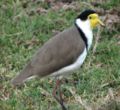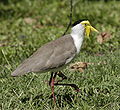- Masked Lapwing
-
Masked Lapwing 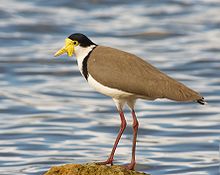
Vanellus miles novaehollandiae Conservation status Scientific classification Kingdom: Animalia Phylum: Chordata Class: Aves Order: Charadriiformes Family: Charadriidae Genus: Vanellus Species: V. miles Binomial name Vanellus miles
(Boddaert, 1783)Subspecies - V. m. miles
- V. m. novaehollandiae
Synonyms Hoplopterus miles (Boddaert, 1783)
Lobibyx miles (Boddaert, 1783)
Lobivanellus miles (Boddaert, 1783)
Tringa miles Boddaert, 1783The Masked Lapwing (Vanellus miles), previously known as the Masked Plover and often called the Spur-winged Plover or just Plover in its native range, is a large, common and conspicuous bird native to Australia, particularly the northern and eastern parts of the continent. It spends most of its time on the ground searching for food such as insects and worms and has several distinctive calls.
Contents
Description
This species is the largest representative of the family Charadriidae, at 35 cm (14 in) and 370 g (13 oz). There are two distinct races which until recently were thought to be separate species. The Northern Australian subspecies (Vanellus miles miles) has an all-white neck and large yellow wattles with the male having a distinctive mask and larger wattles. The subspecies found in the southern and eastern states (Vanellus miles novaehollandiae), and often locally called the Spur-winged Plover, has a black neck-stripe and smaller wattles. (Note that the northern-hemisphere Spur-winged Plover is a different bird.)
The birds have a wide range of calls which can be heard at any time of the day or night: the warning call, a loud defending call, courtship calls, calls to its young, and others. Since this bird lives on the ground it is always alert and even though it rests it never sleeps properly.
Distribution and habitat
Masked Lapwings are most common around the edges of wetlands and in other moist, open environments, but are adaptable and can often be found in surprisingly arid areas.[2] They can also be found on beaches and coastlines. Vanellus miles novaehollandiae spread naturally to Southland, New Zealand in the 1930s and has now spread throughout New Zealand, where it is known as the Spur-winged Plover.
Behaviour
Masked Lapwings are shy and harmless in summer and autumn but are best known for their bold nesting habits, being quite prepared to make a nest on almost any stretch of open ground, including suburban parks and gardens, school ovals, and even supermarket carparks and flat rooftops. They can be particularly dangerous at airports where their reluctance to move from their nesting area – even for large aircraft – has resulted in several bird strikes.[3] Breeding usually happens after Winter Solstice (June 21), but sometimes before. The nesting pair defends their territory against all intruders by calling loudly, spreading their wings, and then swooping fast and low, and where necessary striking at interlopers with their feet and attacking animals on the ground with a conspicuous yellow spur on the carpal joint of the wing.
The bird may also use tactics such as fiercely protecting a non-existent nest, or a distraction display of hopping on a single leg, to attract a potential predator's attention to itself and away from its real nest or its chicks after they have commenced foraging. There seems to be some significant use of language to guide chicks during a perceived dangerous situation. Long calls seem to tell the chicks to come closer to the calling bird; a single chirp every few seconds to ask them to move away. There is a much-believed but incorrect myth that the spur can inject venom. The myth may have been based on fear of the Masked Lapwing's territorial behaviour. Attacks are most vicious on other birds such as ravens, and also on cats and dogs, but once the chicks reach 60% of full size after 2–3 months, the chances of this happening decrease. Strikes are much rarer on humans since they are more aware. Sometimes the bird can damage its wing in a strike but usually survives and is flightless as the wing heals. Some Masked Lapwings, especially those that live in residential suburban areas, may never successfully breed due to increased disturbance from domestic pets, people on footpaths and cars. Commonly two birds are seen together, a male and a female which are almost identical. Many also can be seen in groups at times, especially during feeding on coastlines. The chick reaches full growth after 4 to 5 months and will often stay with the parents for 1 to 2 years resulting in family groups of 3 to 5 birds nesting in one location over the summer.
The birds spend much of the time on the ground, searching for worms and insects to feed on.[2]
Gallery
References
- ^ BirdLife International (2004). Vanellus miles. 2006. IUCN Red List of Threatened Species. IUCN 2006. www.iucnredlist.org. Retrieved on 11 May 2006. Database entry includes justification for why this species is of least concern
- ^ a b "Masked Lapwing Fact Sheet, Lincoln Park Zoo"
- ^ "Masked Lapwings: Managing bird strike risk at Australian airports". ATSB Bird Information Sheet No.3. Australian Transport Safety Bureau. http://www.atsb.gov.au/media/36504/03_masked-lapwings.pdf. Retrieved 13 May 2011.
External links
 Media related to Vanellus miles at Wikimedia Commons
Media related to Vanellus miles at Wikimedia Commons Data related to Vanellus miles at Wikispecies
Data related to Vanellus miles at Wikispecies
Categories:- IUCN Red List least concern species
- Vanellinae
- Birds of South Australia
- Birds of Tasmania
- Birds of Western Australia
- Birds of New Zealand
- Birds of Victoria (Australia)
Wikimedia Foundation. 2010.





